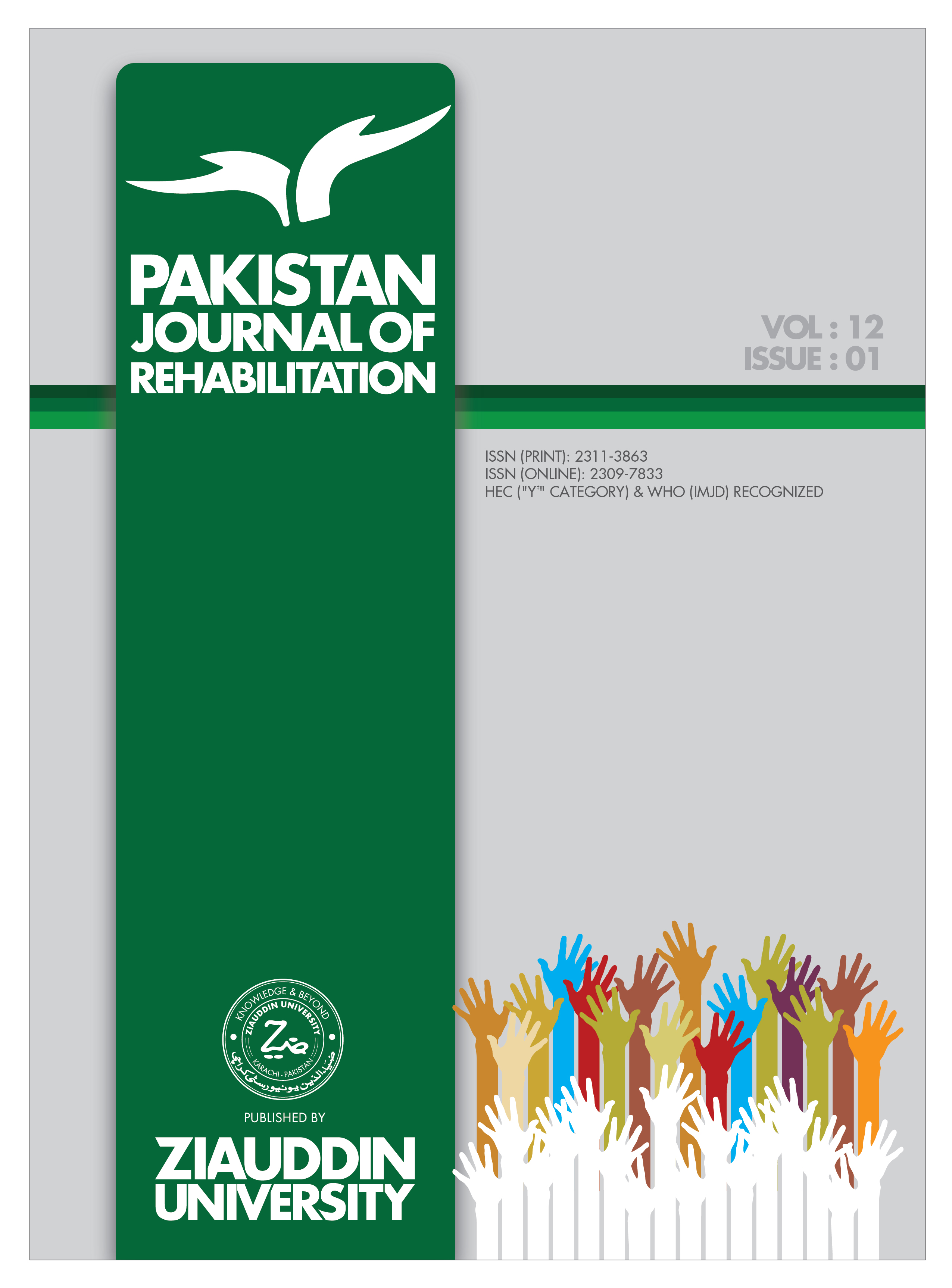A COMPARISON OF THE VISUAL PERCEPTUAL SKILLS IN TYPICAL AND CEREBRAL PALSY CHILDREN
Keywords:
Cerebral palsy, typical, visual perception skills, atypical, visual discrimination, figure groundAbstract
Objective: The purpose of this study is to evaluate the difference at occupational performance skills related to visual perception among typical developing children and cerebral palsy children by using measuring test of MVPT-R.
Design And Sampling Technique: Quantitative cross-sectional study, convenience sampling method.
Study Setting And Participants: A total of 400 Cerebral palsy children (all types) and typical children each from different mainstream schools, rehab centers, pediatric occupational therapy departments, and special education centers located in Karachi.
Interventions / Data Collection: Test of visual perception that is Motor Free visual perceptual test- Revised MVPT-R.
Result: Result shows difference in perceptual ages (PA) between typical and cerebral palsy children. Perceptual age (PA) was greater than the chronological age (CA) in the typical group. Conversely, in the CP group the perceptual age (PA) was lesser than the chronological age (CA).
Conclusion: Visual perception skills play a key role in a child’s achievement at school and at home. Children require intact visual perception for the successful performance of their daily living as well as academic tasks like good eye-hand coordination, handwriting, reading, shape perception, play skills, and copying patterns, etc. This study is helpful to identify those children who have visual perception issues and sorting this problem will form the baseline for better evaluating and planning of useful visual perception activities for typical and cerebral palsy children.
References
Misra H, Aikat R. A Survey of Visual Perceptual Disorders in Typically Developing Children, and Comparison of Motor and Motor-Free Visual Perceptual Training in Such Children.Journal of Neurological Disorders.2016 Sep 8.
ELBASAN B, ATASAVUN S, DÜGER T. Effects of visual perception and motor function on the activities of daily living in children with disabilities. FizyoterapiRehabilitasyon. 2011; 22(3):224-30.
Cho M, Kim D, Yang Y. Effects of visual perceptual intervention on visual-motor integration and activities of daily living performance of children with cerebral palsy. Journal of physical therapy science. 2015; 27(2):411-3.
Newcomer, P., IX Hammill, D. (1973). Visual perception of impaired children: Implications for assessment. Exceptional Children, 1, 33')-336.
Lincoln Thio, P. S., & Senapati, A. A Study on Visual Perceptual Profile In Children With Spastic Diplegic Cerebral Palsy. Swami Vivekanand National Institute of Rehabilitation Training and Research, 20.
Menken C, Cermak SA, Fisher A. evaluating the visual-perceptual skills of children with cerebral palsy. American Journal of Occupational Therapy. 1987 Oct 1;41(10):646-51.
Yakup, K.A.M., David, L.D., Pudzi, N.A., Abd Shukor, A.H., Sabri, M.Q.M. and Dahlan, A., Exploring Visual Perception Among Children With Developmental Disability: A Scoping Review.
Schneck CM. Visual perception. Occupational Therapy for Children.sixth ed. Mosby Inc. 1996:373-403
King, Gillian, et al. "The evaluation of functional, school-based therapy services for children with special needs: a feasibility study." Physical & Occupational Therapy in Pediatrics 18.2 (1998): 1-27.
Caravale, Barbara, et al. "Cognitive development in low risk preterm infants at 3–4 years of life." Archives of Disease in Childhood-Fetal and Neonatal Edition 90.6 (2005): F474-F479.
9. Galli J, Loi E, Molinaro A, Calza S, Franzoni A, Micheletti S, Rossi A, Semeraro F, Fazzi E. Age-related effect on the spectrum of Cerebral Visual Impairment in children with Cerebral Palsy. Frontiers in human neuroscience. 2022 Mar
Caravale, B., Tozzi, C., Albino, G. and Vicari, S., 2005. Cognitive development in low risk preterm infants at 3–4 years of life.Archives of Disease in Childhood-Fetal and Neonatal Edition, 90(6), pp.F474-F479.
Buckle, Fransli. Effectiveness of additional computer-based intervention for the remediation of Visual perceptual skills in 7-9 year old learners diagnosed with attention deficit hyperactivity disorder. Diss.
Beaton, Anthony A., Daniel C. Funk, and Kostas Alexandria. " Operationalizing a theory of Participation in physically active leisure." Journal of Leisure Research 41.2 (2009): 175-203.
King, Gillian A., et al. "Self-evaluation and self-concept of adolescents with physical disabilities." American Journal of Occupational Therapy 47.2 (1993): 132-140.
Kiernan, Chris, and Diana Kiernan. "Challengingbehaviour in schools for pupils with severe learning difficulties." Mental Handicap Research 7.3 (1994): 177-201.
Goldstand, Sarina, Kenneth C. Koslowe, and Shula Parush. "Vision, visual-information processing, and academic performance among seventh-grade schoolchildren: A more significant relationship than we thought?." American Journal of Occupational Therapy 59.4 (2005): 377
Burtner P, Dukeminier A, Ben L, Qualls C, Scott K.Visual perceptual skills and related school functions in children with hemiplegic cerebral palsy.
Tsai LT, Lin KC, Liao HF, Hsieh CL. Reliability oftwo visual-perceptual tests for children with cerebralpalsy.Am J Occup Ther2009;63: 473–80.
Smits DW, Ketelaar M, Gorter JW, et al. Developmentof daily activities in school-age children with cerebralpalsy.Res Dev Disabil2011;32: 222–34.
Khayatzadeh Mahani M, Mardani Shahrbabak B-A, Gholamian HR, Rahgozar M , Soroory MH, Fadaie F. Visual Perceptual Skills in Normal Children Aged 5 to 13 Years in Tehran City. Journal of Rehabilitation. 2011;11(4):8-14 [Persian]
Dehghan A. Standardization of Test of Visual Perceptual Skills in Normal Children Aged 7 to 9 Years in Tehran City: [MSc Thesis]. Tehran, Iran. The University of Social Welfare and Rehabilitation Sciences; 2004 [Persian]
Ramkumar S, Gupta A. A Study on Effect of Occupational Therapy Intervention Program Using Cognitive-Perceptual and Perceptual-Motor Activities on Visual Perceptual Skills in Children with Cerebral Palsy. Indian Journal of Physiotherapy and Occupational Therapy. 2016;10(3): 60. http://doi.org/10.5958/0973- 5674.2016.00083.6
Schmetz E, Magis D, Detraux JJ, Barisnikov K, Rousselle L. Basic visual perceptual processes in children with typical development and cerebral palsy: The processing of surface, length, orientation, and position.Child Neuropsychology. 2019;25(2): 232–262.
Harris M. The Validity and Reliability of Visual Perceptual Standardised Tests in Children from the Gauteng Province, South Africa. 2017.

Downloads
Published
How to Cite
Issue
Section
License
Copyright (c) 2022 Pakistan Journal of Rehabilitation

This work is licensed under a Creative Commons Attribution 4.0 International License.



